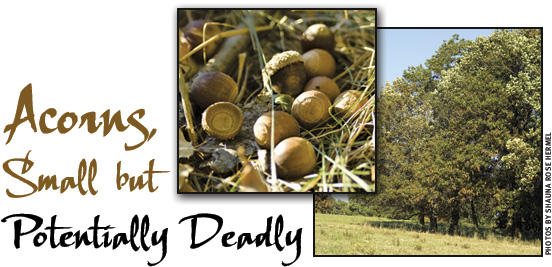HEALTH & NUTRITION...

When cattle eat acorns due to limited forage, it could lead to potentially deadly acorn poisoning.
The weather has not been kind to ranchers and farmers this year, from record-setting droughts to intense flooding and hurricanes. Because of these weather changes, forage availability has been severely affected. With pastures low on forage, cattle may start eating acorns, which can lead to acorn poisoning.
Acorn poisoning, or oak toxicity, occurs when too many acorns or buds are ingested, and the gallotannin in oak foliage creates gastrointestinal and kidney problems.
Tim Evans, a veterinary toxicologist at the University of Missouri–Columbia, says acorns do have nutritional value, but when cattle eat more than 50% of their diet in immature leaves and buds in the spring and acorns in the fall because no other forage is available, that's when the problem starts. As the famous toxicologist Paracelsus said, "The dose makes the poison." Read more.
Feed High-Dollar Corn Wisely
Corn prices eased a little under harvest pressure but there is no question that cattle feeders must adjust to a corn price of $7 per bushel or more. Shawn Walter of Professional Cattle Consultants tells us why that does not necessarily mean fewer days on feed in this 2-minute video clip from Certified Angus Beef LLC staff. Here's the clip:
Tips on Giving Injections Properly
Injections should be administered properly to minimize tissue damage and reduce risks for reactions and side effects. Veterinarian James England of the University of Idaho's Caine Veterinary Teaching Center offers these tips:
- Whether intramuscular (IM) or subcutaneous (sub-Q), all injections should be given in the neck in front of the shoulder.
- Change needles often — at least each time you refill your syringe. Read more.

Rick Rasby
Ridin’ Herd
Buy supplements right
Feed costs make up 50% or more of annual cow costs. Management practices that keep cows grazing to meet the majority of their nutrient needs are almost always more economical than carrying harvested feeds to them to eat.
It is important to understand the nutrient needs of the cow herd. Nutrient needs increase as the cow herd goes through the different stages of production, or as cows progress from mid-gestation to late gestation to lactation. Understanding where the "gaps" are in terms of nutrient deficiencies relative to the base diet can allow producers to know when a supplement is needed. Knowing when to supplement and how much to supplement affects profit potential of the cow-calf enterprise. Read more.
Is Your Herd at Risk for Trich?
Here's a short test to asses your herd's risk of being infected with trichomoniasis.
- 1. Has trichomoniasis been diagnosed in your area?
- 2. Do you utilize open-range grazing?
- 3. Do you purchase mature bulls for breeding purposes?
- 4. Are breeding bulls purchased for your herd without knowledge of their health status?
- 5. Is an extended breeding season used?
- 6. Do you vaccinate for trichomoniasis? Read more.
Putting Cows on Cornstalks?
Rick Rasby, University of Nebraska animal scientist, shares some nutritional considerations that cow-calf producers should weigh as we approach the end of fall harvest in many areas. Here's the minute-and-a-half clip provided by Certified Angus Beef LLC's news team: .
Video Link
For related information on body condition scoring your cows, visit www.CowBCS.info, Angus Productions Inc.'s website devoted to the topic. For more information about feeding and feedstuffs, visit www.FeedingandFeedstuffs.info.
Partnership Focuses on Developing East Coast Fever Vaccine
Developing a vaccine for African fever disease could help develop a vaccine for Texas cattle fever.
A vaccine that protects cattle against East Coast fever, a destructive disease in eastern and central Africa, is being developed by scientists at the U.S. Department of Agriculture (USDA) and the International Livestock Research Institute (ILRI) in Kenya.
Entomologist Glen Scoles, veterinary medical officer Massaro Ueti and research leader Don Knowles at the Agricultural Research Service (ARS) Animal Disease Research Unit (ADRU) in Pullman, Wash., have been working on the collaborative project for more than five years. ARS is USDA's chief intramural scientific research agency. This research, which looks at combination vaccines for tick-borne diseases, supports USDA's priority of promoting international food security. Read more.
Cattle Diseases: Common Conditions/Terms
Click here for a list of common conditions and terms related to beef cattle diseases, such as anaplasmosis, brucellosis, BVD, E. coli, IBR and others.
[Click here to go to the top of the page.]













